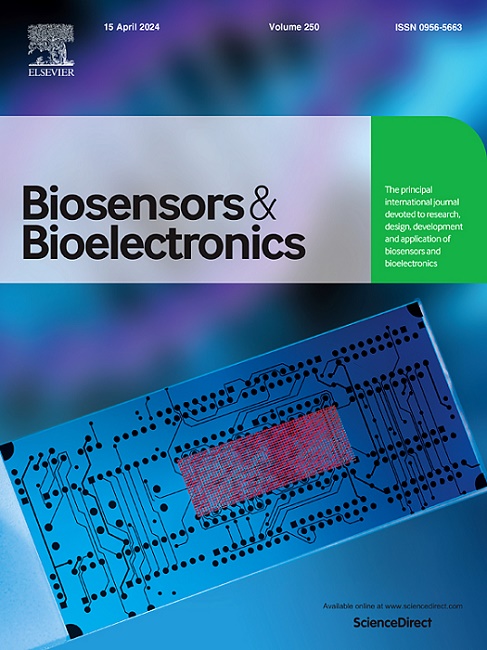Drug functionalized organic electromechanical transistor for rapid and sensitive detection of C-reactive protein
IF 10.7
1区 生物学
Q1 BIOPHYSICS
引用次数: 0
Abstract
C-reactive protein (CRP) is a critical biomarker for inflammation and postoperative recovery monitoring. Organic electrochemical transistor (OECT) plays a key role in CRP detection, however, with a limited sensitivity in physiological environment due to inefficient charge transfer within the Debye length. Here, we introduce rosuvastatin (RSV) drug as a novel recognition element for CRP detection in OECT biosensors. The grafted RSV molecules can inherently interact with CRP through electrostatic bonding interaction, contributing to a direct charge transfer between the captured CRP and the device within the Debye length limitation. Following this, the OECT biosensor exhibits a broad range (10−10 to 10−4 g/mL) for CRP quantification, with a short response time of 2 min. Moreover, the devices can realize selective CRP recognition in serum, demonstrating the great potential of drug receptors in electronic biosensor functionalization. This strategy paves a new way for developing ultrasensitive OECT biosensors towards accurate and reliable in-situ biomarker monitoring for convenient disease diagnose.
用于c反应蛋白快速灵敏检测的药物功能化有机机电晶体管
c反应蛋白(CRP)是炎症和术后恢复监测的重要生物标志物。有机电化学晶体管(OECT)在CRP检测中起着关键作用,但由于德拜长度内电荷转移效率低,在生理环境下灵敏度有限。本文介绍瑞舒伐他汀(RSV)药物作为OECT生物传感器检测CRP的新识别元件。接枝的RSV分子可以通过静电键相互作用固有地与CRP相互作用,有助于捕获的CRP与Debye长度限制内的设备之间的直接电荷转移。在此之后,OECT生物传感器显示出CRP定量的宽范围(10−10至10−4 g/mL),反应时间短至2分钟。此外,该设备可以在血清中实现选择性CRP识别,证明了药物受体在电子生物传感器功能化中的巨大潜力。该策略为开发超灵敏的OECT生物传感器,实现准确可靠的原位生物标志物监测,方便疾病诊断铺平了新的道路。
本文章由计算机程序翻译,如有差异,请以英文原文为准。
求助全文
约1分钟内获得全文
求助全文
来源期刊

Biosensors and Bioelectronics
工程技术-电化学
CiteScore
20.80
自引率
7.10%
发文量
1006
审稿时长
29 days
期刊介绍:
Biosensors & Bioelectronics, along with its open access companion journal Biosensors & Bioelectronics: X, is the leading international publication in the field of biosensors and bioelectronics. It covers research, design, development, and application of biosensors, which are analytical devices incorporating biological materials with physicochemical transducers. These devices, including sensors, DNA chips, electronic noses, and lab-on-a-chip, produce digital signals proportional to specific analytes. Examples include immunosensors and enzyme-based biosensors, applied in various fields such as medicine, environmental monitoring, and food industry. The journal also focuses on molecular and supramolecular structures for enhancing device performance.
 求助内容:
求助内容: 应助结果提醒方式:
应助结果提醒方式:


